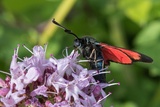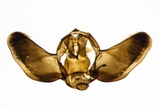Zygaena transalpina (Esper, 1780) Species
Last modified: Dec. 5, 2024, 2:38 p.m.
This very rare and local species is only known from a few localities in three southern provinces.
Details
- Classification
- Family: Zygaenidae > Subfamily: Zygaeninae > Genus: Zygaena > Subgenus: Zygaena > Species: Zygaena transalpina
- Vernacular names
- Zuidelijke sint-jansvlinder (NL), Southern Six Spot Burnet (EN), La Zygène transalpine (FR)
- Synonyms
- Zygaena hippocrepidis (Hübner, 1799)
- First mention in Belgium
- De Sélys-Longchamps E. 1857a. Catalogue des Insectes Lépidoptères de la Belgique. — Annales de la Société entomologique belge 1: 1–111. On page 44.
- Status
-
Native
Distribution
Imago
Wingspan 28–32 mm. Shiny black forewings with 6 red spots, red hindwings with a narrow black border. The underside of the forewing of Z. transalpina is covered in bright red with a clearly separated black front and outer edge. In contrast, Z. filipendulae has only a faint reddish tinge around the spots on the underside of the forewing, and the front and outer edges are less clearly defined.
On the upper side, the forewing spots in Z. transalpina are usually clearly separated and appear very sharp due to a thin black border, while in Z. filipendulae they are often in pairs and give a more blurred impression.
In the relevant literature, the white antenna tips of Z. transalpina are often mentioned as a sure distinguishing feature from Z. filipendulae, which almost always has black antenna tips. However, there are also specimens of Z. transalpina with completely black antenna tips, and when specimens have been worn, this feature is hardly or not visible anymore
Bionomics
Larvae live freely on the food plant. Cocoon detached on the stems of grasses. The adults are active during the day.
Flight periods
The adults fly mainly in June and July.
Observed on
- Host plant (species):
- Hippocrepis comosa
- Host plant (genera):
- Lotus and Coronilla
The larva lives mainly on Hippocrepis comosa and Coronilla spp.
Habitat
It inhabits mostly dry, sunny locations such as calcareous grasslands.










